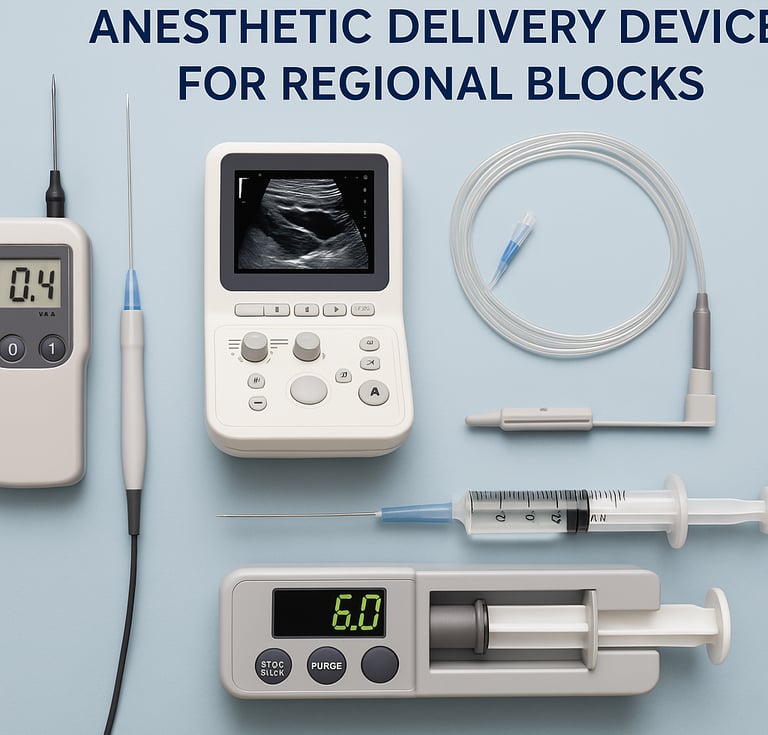Anesthetic Delivery Devices for Regional Blocks: Innovations and Applications
Regional anesthesia has evolved significantly with the advent of innovative anesthetic delivery devices that enhance accuracy, safety, and efficacy. Devices such as nerve stimulators, ultrasound-guided systems, and smart drug delivery tools have revolutionized the field, making regional blocks more accessible and reliable. This article explores key technologies, their applications, cost considerations, and clinical evidence supporting their use.
medtechoptions.com
4/6/20252 min read


1. Nerve Stimulators: Precision Through Electrical Feedback
Nerve stimulators use low-intensity electrical currents to locate peripheral nerves, enabling precise anesthetic injection.
How They Work: Deliver electrical impulses through an insulated needle; motor response indicates proximity to the target nerve.
Clinical Use: Common in brachial plexus, femoral, and sciatic nerve blocks.
Benefits:
Increases first-attempt success rates.
Reduces risk of nerve damage compared to blind techniques.
Cost Range: $300–$1,500 (depending on brand and functionality).
Popular Models:
B. Braun Stimuplex HNS12
Pajunk MultiStim SENSOR
2. Ultrasound-Guided Regional Anesthesia (UGRA)
Ultrasound guidance has become the gold standard for regional blocks, offering real-time visualization of nerves, vessels, and local anesthetic spread.
How It Works: High-frequency ultrasound probes image soft tissues; anesthetists guide needle placement and monitor drug spread.
Clinical Use: Widely used for upper and lower limb blocks, TAP blocks, and paravertebral blocks.
Benefits:
Higher block success rates.
Reduced complication rates (e.g., vascular puncture, pneumothorax).
Lower doses of local anesthetics needed.
Cost Range: $15,000–$40,000 for dedicated portable systems; $50–$150 per procedure for consumables.
Top Systems:
GE Venue Go
SonoSite Edge II (Fujifilm)
Mindray TE Series
Citation:
Sites, B. D., et al. (2010). "Ultrasound guidance improves the success rate and safety of peripheral nerve blocks: a meta-analysis." Regional Anesthesia and Pain Medicine, 35(4), 317–320.
3. Drug Delivery Innovations: Infusion Pumps and Liposomal Formulations
Infusion Pumps
Continuous peripheral nerve block (CPNB) pumps deliver local anesthetics over several days for postoperative analgesia.
Benefits:
Reduces opioid consumption.
Improves mobility and patient satisfaction.
Cost Range: $300–$800 per disposable pump unit.
Liposomal Bupivacaine
An extended-release formulation providing analgesia for up to 72 hours.
Brand: Exparel (Pacira Pharmaceuticals)
Cost: $285–$315 per dose.
Use Case: Infiltration in surgical sites or peripheral blocks (e.g., interscalene).
Citation:
Ilfeld, B. M., et al. (2018). "Liposomal bupivacaine: limitations and potential role in regional anesthesia." Current Opinion in Anesthesiology, 31(5), 614–620.
Conclusion
Technological innovation has made regional anesthesia safer, more efficient, and more precise. From nerve stimulators to real-time ultrasound and advanced drug delivery systems, these tools have enhanced the ability to provide targeted, opioid-sparing pain relief across a variety of surgical procedures. Clinicians must weigh cost, patient needs, and procedural complexity when selecting the appropriate anesthetic delivery devices for regional blocks.
References
Sites, B. D., et al. (2010). "Ultrasound guidance improves the success rate and safety of peripheral nerve blocks: a meta-analysis." Regional Anesthesia and Pain Medicine, 35(4), 317–320.
Ilfeld, B. M., et al. (2018). "Liposomal bupivacaine: limitations and potential role in regional anesthesia." Current Opinion in Anesthesiology, 31(5), 614–620.
Have you considered these options for your OR? Kindly share your feedback
